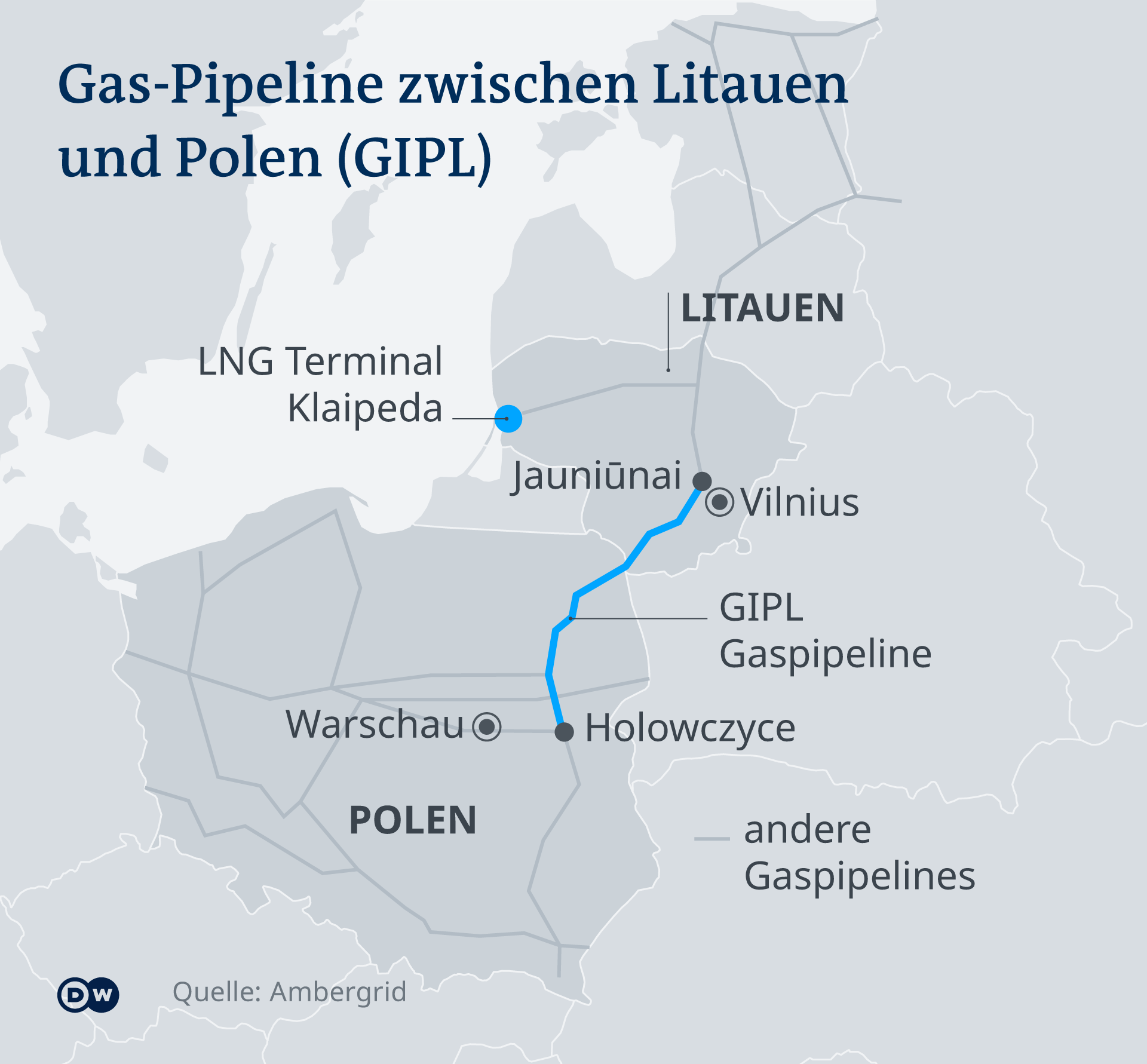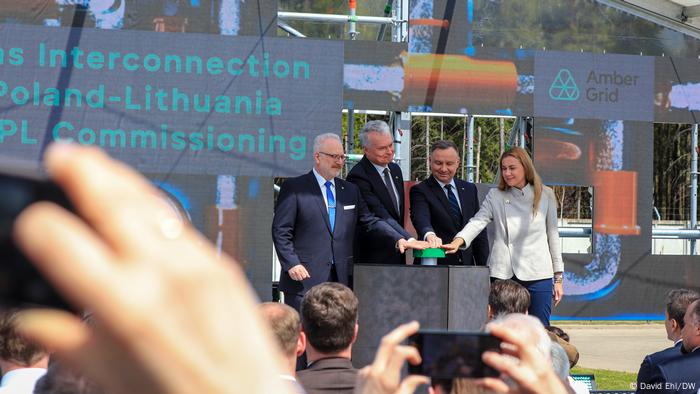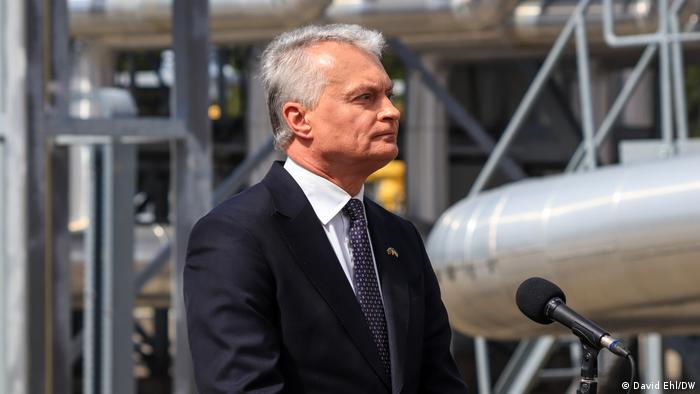A new pipeline connects the Baltic States with Poland and thus with the entire European gas network. It comes at the right time for Poland – for Lithuania it is just one building block in a larger plan.

The GIPL pipeline, which cost around 500 million euros, was supported by the EU with 300 million euros
In a field near the Lithuanian village of Jauniūnai, the yellow pipeline appears behind a fence for a few meters, only to then bend down again and continue underground. Otherwise you don't see much of the 500 km long gas pipeline that starts here and that recently connects Lithuania and Poland. The three compressor systems on a company site are more important than a few yellow pipes under a blue sky: They bring the natural gas to the necessary pressure to force it through the pipe to beyond the Polish border.

Only a few yellow tubes at the beginning: the GIPL pipeline connects Lithuania and Poland
The “Gas Interconnection Poland-Lithuania” (GIPL) is part of a larger plan to further integrate Lithuania, together with the other two Baltic states Latvia and Estonia, into the energy markets of the European Union. The Baltic States used to be considered an “energy island” within the EU, says Romas Švedas, a former EU diplomat and Lithuania's Deputy Energy Minister, who is now an independent consultant with a teaching position at Vilnius University: “The importance is that the three Baltic states to connect the energy system and pipeline network of continental Europe.”
The pipeline is going online at the right time – especially for Poland
This outlines the task of the GIPL pipeline: Instead of bringing the raw material from the extraction site to the consumer, as is the case with the entire Russian pipeline network, it should enable energy trading and the exchange of resources among each other. The market decides in which direction the gas is currently being routed. And because Russia stopped its gas deliveries to Poland and Bulgaria from one day to the next at the end of April, gas has been flowing towards Poland through the GIPL pipeline since it went into operation at the beginning of May.

“The pipeline connects the Baltic States with the rest of Europe,” explains Martynas Nagevičius, President of the Lithuanian Renewable Energy Association. “That means that it also connects Europe's problems with the Baltic States.” As a result, he expects further price increases in the Baltic States, because Western Europe is moving away from Russian gas at record speed and the resource is scarce as a result.
When construction began in 2015, no one thought that the pipe would be needed so urgently for its completion – now, at a commissioning ceremony, Poland's President Andrzej Duda thanked everyone who contributed to the timely completion “at a time when we really need the gas supplies .” Lithuania's President Gitanas Nausėda spoke of “energy blackmail from the East”: “Russia's war against Ukraine has confirmed our many years of experience: Russia was and is not a reliable partner.”
The Baltic path to energy independence
The Baltic States, on the other hand, solemnly announced on April 1 that they had made themselves completely independent of Russian gas supplies: They now mainly burn gas from the USA and Norway. It is delivered via an LNG terminal in Klaipeda, Lithuania, whose capacity more or less covers the entire consumption of the Baltic States. There are also large underground gas storage facilities in Latvia, a pipeline connection to Finland in the north and now the new pipe in the south to Poland. According to the operating group, the only oil refinery in Lithuania has also not been supplied from Russia since April – Lithuania has also been pushing for the EU-wide oil embargo for some time.
In the Baltic States, the issue of energy cannot be separated from security policy: “We have a difficult history and difficult relations with our eastern neighbors,” says Nagevičius. “Perhaps we Lithuanians have always been a bit suspicious of Russia and Belarus. That's probably one reason why Lithuania has invested in energy security projects.”

A push of a button for the cameras: When Presidents Egil Levits (Latvia), Gitanas Nauseda (Lithuania) and Andrzej Duda (Poland) and the Estonian EU Energy Commissioner Kadri Simson on May 5. symbolically opened the pipeline, the gas had been flowing for days
When Lithuania was the first republic to break away from the Soviet Union in 1990 and unilaterally declared its independence, Moscow stopped oil supplies. Gasoline was rationed and production had to be stopped in some factories. The embargo ended after three months, after Lithuania agreed to political negotiations about its own future. Accordingly, Lithuania has always been skeptical about Western European energy projects with Russia, especially about the two Nord Stream pipelines to Germany.
The key: end the monopoly, reduce consumption
The Baltic gas import ban as a result of the Russian attack on Ukraine was therefore not an impulse decision, but the result of long preparatory work: In 2014, Lithuania was the first Baltic country to break away from the vertical monopoly of the Russian gas giant Gazprom, which traditionally charged higher prices in the Baltic than in, for example Germany. In an interview with DW, energy consultant Švedas recalled how he presented the associated legislative package in parliament at the time. “It was a very painful process to get the votes for it, while Lithuania feared difficulties as a member of the EU and NATO.” The Lithuanian example was followed by Estonia in 2015 and Latvia in 2017.
Watch video 03:10
LNG terminal supplies Lithuania with liquid gas
However, the reduction in consumption was also particularly important for the phase-out of Russian gas: In Lithuania, every second household is connected to the district heating network. For a long time, the central burners were heated almost exclusively with Russian gas; In 2020, however, according to the Lithuanian district heating association, this only accounted for 17 percent – compared to 80 percent from biomass.
Next construction site: electricity
From Nagevičius' point of view, the biggest weak point is electricity: In the course of joining the EU in 2004, Lithuania undertook to shut down its Ignalina nuclear power plant within five years. The reactor was similar to that in Chernobyl; However, the shutdown made Lithuania very dependent on electricity imports, and two-thirds of the demand is still being supplied today. The government is now expanding wind and solar power: by 2035 they are to be expanded from around 25 to 93 percent of the Lithuanian electricity mix.
To make matters worse, the three Baltic states are still connected to the Russian power grid, not to the Western European power grid, more than 30 years after they regained their independence. “The system is not secure because we depend on system services that they run for us,” Nagevičius told DW. “The frequency depends on Russia.”

President Nauseda sees the pipeline as an incentive, now too to speed up the conversion of the power grid
Preparations to connect the Baltic States to the European grid have been underway for years, and some connecting lines have already been laid. Lithuania is now pushing in Brussels to revise the schedule and complete the switch before 2025: when the pipeline was opened, President Nausėda brought up the first quarter of 2024 for this purpose. If the political will is there, projects can be completed “quicker than planned”.

